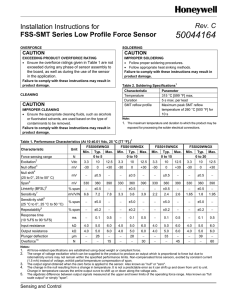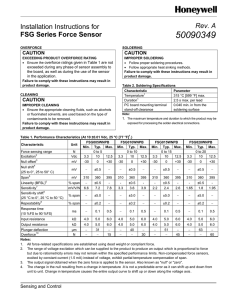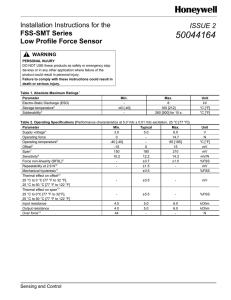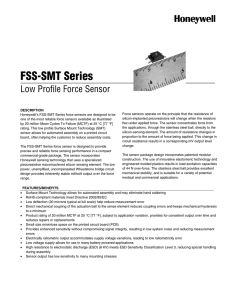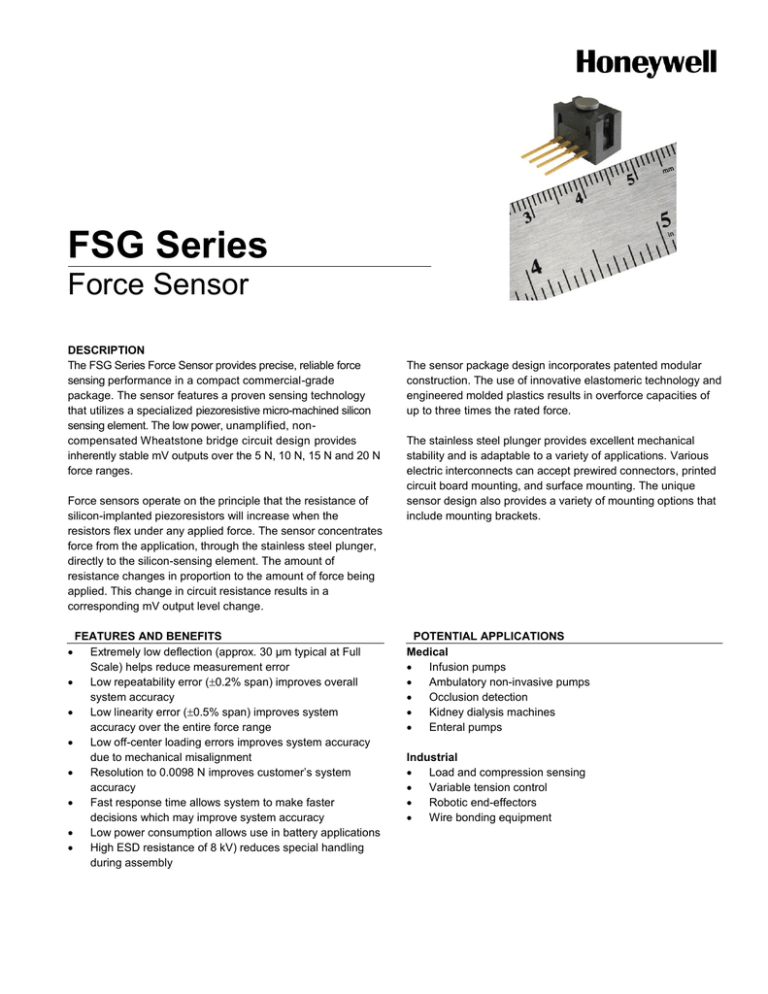
FSG Series
Force Sensor
DESCRIPTION
The FSG Series Force Sensor provides precise, reliable force
sensing performance in a compact commercial-grade
package. The sensor features a proven sensing technology
that utilizes a specialized piezoresistive micro-machined silicon
sensing element. The low power, unamplified, noncompensated Wheatstone bridge circuit design provides
inherently stable mV outputs over the 5 N, 10 N, 15 N and 20 N
force ranges.
Force sensors operate on the principle that the resistance of
silicon-implanted piezoresistors will increase when the
resistors flex under any applied force. The sensor concentrates
force from the application, through the stainless steel plunger,
directly to the silicon-sensing element. The amount of
resistance changes in proportion to the amount of force being
applied. This change in circuit resistance results in a
corresponding mV output level change.
FEATURES AND BENEFITS
Extremely low deflection (approx. 30 µm typical at Full
Scale) helps reduce measurement error
Low repeatability error (0.2% span) improves overall
system accuracy
Low linearity error (0.5% span) improves system
accuracy over the entire force range
Low off-center loading errors improves system accuracy
due to mechanical misalignment
Resolution to 0.0098 N improves customer’s system
accuracy
Fast response time allows system to make faster
decisions which may improve system accuracy
Low power consumption allows use in battery applications
High ESD resistance of 8 kV) reduces special handling
during assembly
The sensor package design incorporates patented modular
construction. The use of innovative elastomeric technology and
engineered molded plastics results in overforce capacities of
up to three times the rated force.
The stainless steel plunger provides excellent mechanical
stability and is adaptable to a variety of applications. Various
electric interconnects can accept prewired connectors, printed
circuit board mounting, and surface mounting. The unique
sensor design also provides a variety of mounting options that
include mounting brackets.
POTENTIAL APPLICATIONS
Medical
Infusion pumps
Ambulatory non-invasive pumps
Occlusion detection
Kidney dialysis machines
Enteral pumps
Industrial
Load and compression sensing
Variable tension control
Robotic end-effectors
Wire bonding equipment
FSG Series
1
Table 1. Performance Characteristics (At 10 ±0.01 Vdc, 25 °C [77 °F].)
FSG005WNPB
FSG010WNPB
Characteristic
Unit
Min. Typ. Max. Min. Typ. Max.
Force sensing range
N
0 to 5
0 to 10
2
Excitation
Vdc
3.3
10
12.5
3.3
10
12.5
3
Null offset
4
Null shift
(25 to 0°, 25 to 50° C)
FSG015WNPB
Min. Typ. Max.
0 to 15
3.3
10
12.5
FSG020WNPB
Min. Typ. Max.
0 to 20
3.3
10
12.5
mV
-30
0
+30
-30
0
+30
-30
0
+30
-30
0
+30
mV
±0.5
±0.5
±0.5
±0.5
mV
% span
310
360
±0.5
395
310
360
±0.5
395
310
360
±0.5
395
310
360
±0.5
395
mV/V/N
8
Sensitivity shift
% span
(25 °C to 0°, 25 °C to 50 °C)
9
Repeatability
% span
6.6
7.2
7.8
3.3
3.6
3.9
2.2
2.4
2.6
1.65
1.8
1.95
±5.0
±5.0
±5.0
±5.0
±0.2
±0.2
±0.2
±0.2
ms
0.1
0.5
0.1
0.5
0.1
0.5
0.1
0.5
kΩ
kΩ
4.0
4.0
5.0
5.0
6.0
6.0
4.0
4.0
5.0
5.0
6.0
6.0
4.0
4.0
5.0
5.0
6.0
6.0
4.0
4.0
5.0
5.0
6.0
6.0
µm
31
40
51
63
N
15
30
45
60
5
Span
6
Linearity (BFSL)
7
Sensitivity
Response time
(10 %FS to 90 %FS)
Input resistance
Output resistance
Plunger deflection
10
Overforce
Notes:
1. All force-related specifications are established using dead weight or compliant force.
2. The range of voltage excitation which can be supplied to the product to produce an output which is
proportional to force but due to ratiometricity errors may not remain within the specified performance
limits. Non-compensated force sensors, excited by constant current (1.5 mA) instead of voltage, exhibit
partial temperature compensation of span.
3. The output signal obtained when the zero force is applied to the sensor. Also known as "null" or "zero".
4. The change in the null resulting from a change in temperature .It is not a predictable error as it can shift
up and down from unit to unit. Change in temperature causes the entire output curve to shift up or down
along the voltage axis.
5. The algebraic difference between output signals measured at the upper and lower limits of the operating
force range. Also known as "full scale output" or simply "span".
6. The maximum deviation of product output from a straight line fitted to output measured over the operating
force range. The straight line through a set of points which minimizes the sum of the square of the
deviations of each of the points from the straight line.
7. The ratio of output signal change to the corresponding input force change. Sensitivity is determined by
computing the ratio of span to the specified operating force range multiplied by the supply voltage
being used.
8. The maximum deviation in sensitivity due to changes in temperature over the operating temperature
range, relative to sensitivity measured at 25 °C.
9. The maximum difference between output readings when the same force is applied consecutively, under
the same operating conditions, with force approaching from the same direction within the operating
force range.
10. The maximum force which may safely be applied to the product for it to remain in specification once
force is returned to the operating force range. Exposure to higher forces may cause permanent damage
to the product. Unless otherwise specified, this applies to all temperatures within the operating
temperature range.
CAUTION
EXCEEDING PRODUCT
OVERFORCE RATING
Ensure the overforce
ratings given in Table 1
are not exceeded
during any phase of
sensor assembly to the
board, as well as during
the use of the sensor in
the application.
Failure to comply with
these instructions may
result in product
damage.
Table 2. Environmental Specifications
Characteristic
Parameter
1
Operating temperature
-40 °C to 85 °C [-40 °F to 185 °F]
Shock
qualification tested to 150 g
Vibration
qualification tested to 0 Hz to 2 kHz, 20 g sine
2
MCTF (Mean Cycles to Failure)
20 million at 25 °C [77 °F]
Output ratiometric
within supply range
Notes:
1. The temperature range over which the product may safely be exposed without excitation or force applied. Under these conditions the
product will remain in specification after excursion to any temperatures in this range. Exposure to temperatures beyond this range may cause
permanent damage to the product.
2. MCTF is a basic measure of reliability for a non-repairable device. It is the mean number of cycles to maximum operating force over which
a sensor can be expected to operate until failure. The mean value is determined statistically from a probability distribution for failures
based upon test data. MCTF may vary depending on the specific application in which a sensor is utilized.
2
sensing.honeywell.com
Force Sensor
Table 3. Absolute Maximum Ratings
Characteristic
2
Storage temperature
3
Solderability
ESD
1
Parameter
-40 °C to 100 °C [-40 °F to 212 °F]
2.5 s at 315 °C [599 °F]
Meets ESD Sensitivity Classification Level 3B
Notes:
1. The extreme limits that the product can withstand without damage to the product.
2. The temperature range over which the product may safely be exposed without excitation or force applied. Under these conditions, the
product will remain in the specification after excursions to any temperature in this range. Exposure to temperatures beyond this range may
cause permanent damage to the product.
3. The maximum temperature and duration to which the product may be exposed for processing the solder electrical connections.
Figure 1. Excitation Schematic (Excitation at 5 Vdc Typ., 6 Vdc max.)
1. Circled numbers refer to sensor terminals (pins).
Pin 1 = Supply Vs (+), Pin 2 = Output Vo (+), Pin 3 = Ground Vg (-), Pin 4 = Output Vo (-)
1
2. The force sensor may be powered by voltage or current. Maximum supply voltage is not
+
to exceed 6 V. Maximum supply current is not to exceed 1.2 mA. Power is applied
Vs
+ Vo 2
4
across Pin 1 and Pin 3.
3. The sensor output should be measured as a differential voltage across Pin 2 and
Pin 4 (Vo = Vo(+) - Vo(-)). The output is ratiometric to the supply voltage. Shifts in
3
supply voltage will cause shifts in output. Neither Pin 2 nor Pin 4 should be tied to
ground or voltage supply.
Figure 2. Sensor Mounting Dimensions (For reference only: mm/[in].)
FSG005WNPB, FSG010WNPB. FSG015WNPB, FSG020WNPB
Figure 3. Plastic Mounting Bracket Mounting
Dimensions (For reference only: mm/[in].)
PC15132
Bracket With and Without Sensor
Force Sensing Range
Actuator Height
0 N to 5 N
0 N to 10 N
1,33 ±0.28 mm
[0.05 ±0.01 in]
0 N to 15 N
0 N to 20 N
1,31 ±0.27 mm
[0.05 ±0.01 in]
Honeywell Sensing and Control
3
Order Guide
Catalog Listing
Description
FSG005WNPB
FSG Series Force Sensor, 0 N to 5 N force sensing range, blister pack packaging
FSG010WNPB
FSG Series Force Sensor, 0 N to 10 N force sensing range, blister pack packaging
FSG015WNPB
FSG Series Force Sensor, 0 N to 15 N force sensing range, blister pack packaging
FSG020WNPB
FSG Series Force Sensor, 0 N to 20 N force sensing range, blister pack packaging
PC15132
Plastic mounting bracket
WARNING
WARNING
MISUSE OF DOCUMENTATION
The information presented in this product sheet is for
reference only. Do not use this document as a product
installation guide.
Complete installation, operation, and maintenance
information is provided in the instructions supplied with
each product.
Failure to comply with these instructions could result
in death or serious injury.
WARRANTY/REMEDY
Honeywell warrants goods of its manufacture as being free of
defective materials and faulty workmanship. Honeywell’s
standard product warranty applies unless agreed to otherwise
by Honeywell in writing; please refer to your order
acknowledgement or consult your local sales office for specific
warranty details. If warranted goods are returned to Honeywell
during the period of coverage, Honeywell will repair or replace,
at its option, without charge those items it finds defective. The
foregoing is buyer’s sole remedy and is in lieu of all other
warranties, expressed or implied, including those of
merchantability and fitness for a particular purpose. In no
event shall Honeywell be liable for consequential, special,
or indirect damages.
While we provide application assistance personally, through
our literature and the Honeywell web site, it is up to the
customer to determine the suitability of the product in the
application.
PERSONAL INJURY
DO NOT USE these products as safety or emergency stop
devices or in any other application where failure of the
product could result in personal injury.
Failure to comply with these instructions could result
in death or serious injury.
SALES AND SERVICE
Honeywell serves its customers through a worldwide network
of sales offices, representatives and distributors. For
application assistance, current specifications, pricing or name
of the nearest Authorized Distributor, contact your local sales
office or:
E-mail: info.sc@honeywell.com
Internet: sensing.honeywell.com
Phone and Fax:
Asia Pacific
+65 6355-2828
+65 6445-3033 Fax
Europe
+44 (0) 1698 481481
+44 (0) 1698 481676 Fax
Latin America
+1-305-805-8188
+1-305-883-8257 Fax
USA/Canada
+1-800-537-6945
+1-815-235-6847
+1-815-235-6545 Fax
Specifications may change without notice. The information we
supply is believed to be accurate and reliable as of this
printing. However, we assume no responsibility for its use.
Sensing and Control
Honeywell
1985 Douglas Drive North
Golden Valley, MN 55422
sensing.honeywell.com
008028-2-EN
February 2013
© 2013 Honeywell International Inc. All rights reserved.


